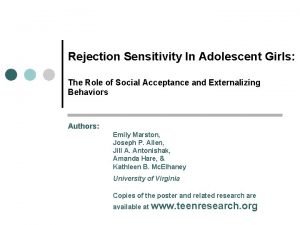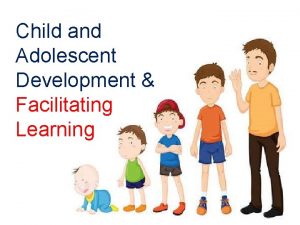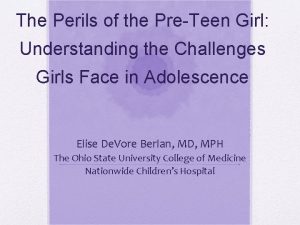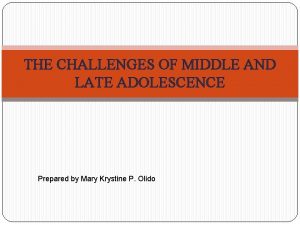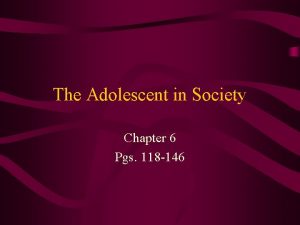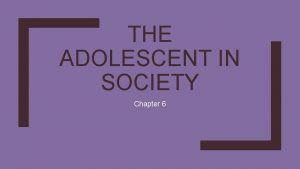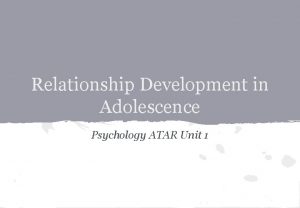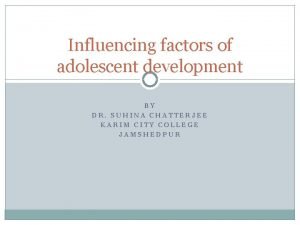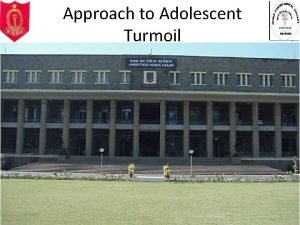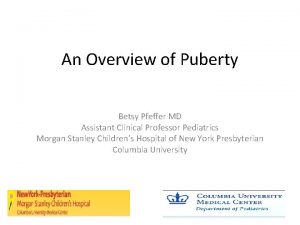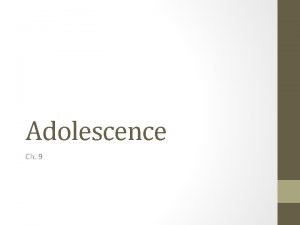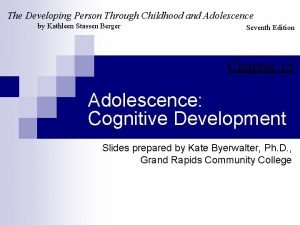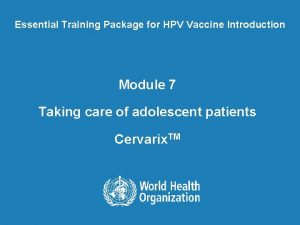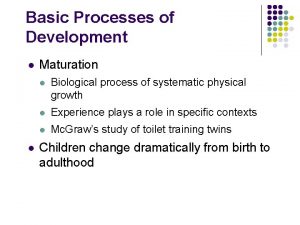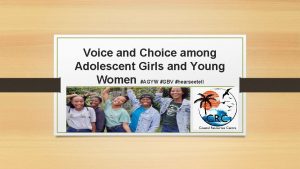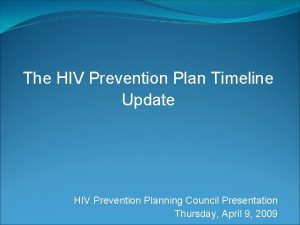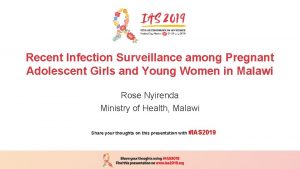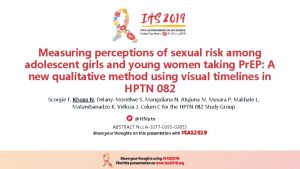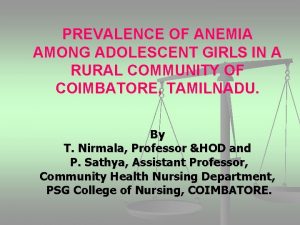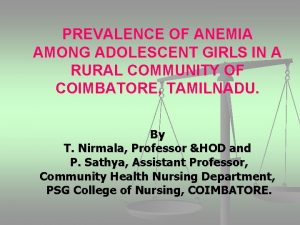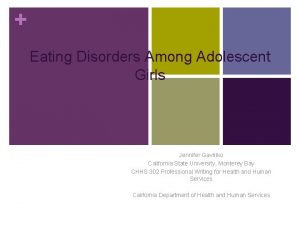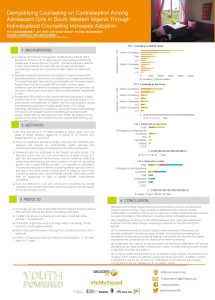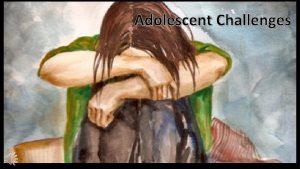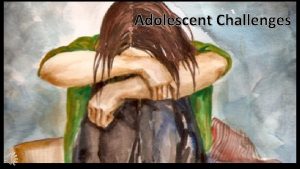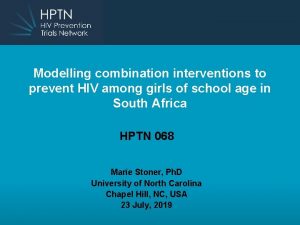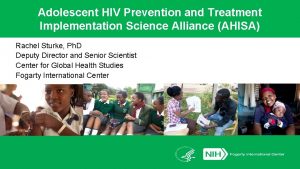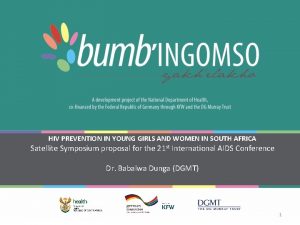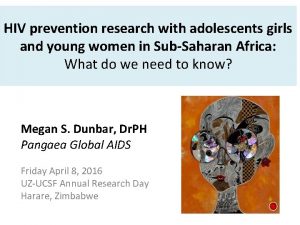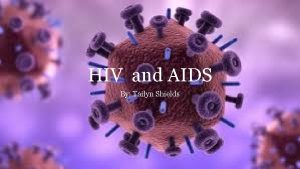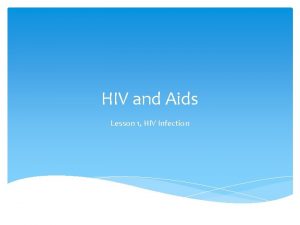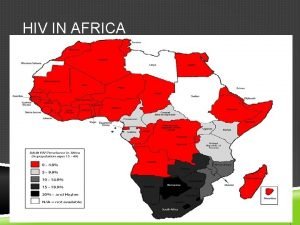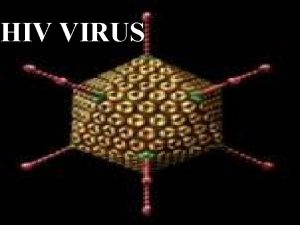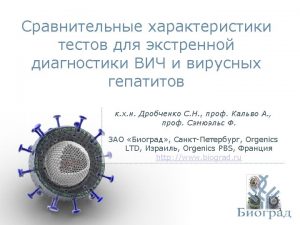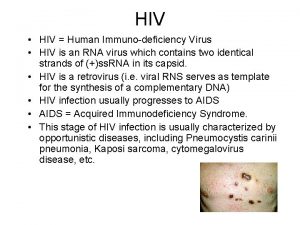HIV and prevention challenges among adolescent girls and



























- Slides: 27

HIV and prevention challenges among adolescent girls and young women Presented at the PACT Preconference meeting, 21/07/18, IAS 2018, Amsterdam Dr. Chewe Luo MD, Ph. D, FRCP Associate Director, Programmes, Chief HIV Section, UNICEF Headquarters, New York © UNICEF/UN 070230/Chisiza

Presentation outline • Results to date and state of the epidemic • Where are we headed? – Global commitments • Understanding determinants of infection • What do we need to do? • Conclusion

HIV investments have resulted in fewer deaths and new child infections among children PMTCT Coverage and number of new HIV infections among children aged 0 -14, 2000 -2017 New HIV infections 90% 400, 000 350, 000 250, 000 60% 300, 000 60% 50% 250, 000 50% 39% 200, 000 150, 000 25% 17% 100, 000 50, 000 3% 1% 1% 4% 6% 20 00 20 01 20 02 20 03 20 04 20 05 20 06 20 07 20 08 20 09 20 10 20 11 20 12 20 13 20 14 20 15 20 16 20 17 - Data source: Global AIDS Monitoring 2018 and UNAIDS 2018 estimates 40% 30% 20% 10% 0% PMTCT Coverage Number of new HIV infections 300, 000 79%80% 77%78% 80% 71% 67% 70% Number of AIDS-related deaths 450, 000 ART Coverage AIDS-related deaths 60% 52% 49% 45% 50% 41% 200, 000 36% 40% 31% 150, 000 27% 30% 22% 100, 000 17% 20% 13% 10% 50, 000 7% 4% 3% 2% 1% 10% - 0% ART Coverage PMTCT Coverage Paediatric ART coverage and number of AIDS-related deaths among children aged 0 -14, 2000 -2017 HIV and prevention challenges among adolescent girls and young women UNICEF | for every child

We have more to do to achieve epidemic control Although there are less new infections in younger children, for adolescents the decline has flatlined Data source: UNAIDS 2018 estimates HIV and prevention challenges among adolescent girls and young women UNICEF | for every child

We have to address multiple vulnerabilities in adolescent girls and young women to radically change the trajectory towards the 75% reduction, down to <100, 000 new infections Estimated number of new HIV infections among adolescent girls and young women (15 -24 years); 2010 -2017 trends with 2017 -2020 projections and targets Infections: status-quo scenario Infections: Super-Fast Track scenario 500000 400000 300000 200000 100000 0 2011 2012 Data source: UNICEF analysis of UNAIDS 2018 estimates 2013 2014 2015 2016 2017 2018 2019 2020 HIV and prevention challenges among adolescent girls and young women UNICEF | for every child

There were 340, 000 new infections among adolescent girls and young women, in 2017 • Infections among AGYW is almost a quarter (21%) of all adult new infections • 82% of these infections occurred in sub-Saharan Africa • Proportion > a quarter in sub-Saharan Africa (28%) • Outside sub-Saharan Africa, AGYW represent 10% of new infections • Key populations and their partners represent about 40%of new infections outside sub-Saharan Africa HIV and prevention challenges among adolescent girls and young women UNICEF | for every child

In three regions, adolescent girls experience more new infections than adolescent boys Data source: UNAIDS 2018 estimates HIV and prevention challenges among adolescent girls and young women UNICEF | for every child

HIV and prevention challenges among adolescent girls and young women UNICEF | for every child In many countries adolescent girls are at higher risk than boys for HIV infection Proportion of new adolescent HIV infections occurring among adolescent girls, 2017 Data source: UNAIDS 2018 estimates

About 2. 4 million adolescent girls and young women are living with HIV in 2017; 2. 0 million live in sub-Saharan Africa Distribution of adolescent girls and young women aged 15 -24 living with HIV, by region, 2017 Latin America and South Asia the 4% Caribbean East Asia 4% and the Pacific 4% West and Central Africa 23% Distribution of adolescent girls and young women aged 15 -24 living with HIV in sub-Saharan Africa, by country, 2017 [CATEGORY NAME]Rest of the region [PERCENTA GE] South Africa 25% Eastern and Southern Africa 62% Zimbabwe 3% Nigeria 15% Zambia 5% United Republic of Tanzania Uganda 6% 6% Data source: UNAIDS 2018 estimates Kenya 6% Mozambique 8% HIV and prevention challenges among adolescent girls and young women UNICEF | for every child

Getting ahead of HIV with adolescent girls Data source: Demographic & Health Surveys (DHS) 2013 -2017 HIV and prevention challenges among adolescent girls and young women UNICEF | for every child

Adolescents living with HIV receive inadequate access to antiretroviral therapy Percentage of adolescents aged 10 -19 living with HIV who were on ART in 2017, by age and sex, 40 countries 100% 90% 80% 70% 61% 60% 50% 41% 37% 40% 31% 30% 20% 10% 0% Adolescents 10 -14 Adolescents 15 -19 Boys 15 -19 Girls 15 -19 2018 HIV Estimates – UNICEF | for every child

Where are we headed ? 2016 HIV High Level Forum Commitments In 2016, the world committed to ambitious HIV: Prevention targets a) Children (start free) - <20, 000 new infections in 2020 b) Adolescents &young women (stay free) - <100, 000 in 2020 Treatment Targets Children and adolescents (AIDS Free) • Provide life long HIV treatment to 95% of children and adolescents living with HIV How we perform in the remaining 29 months around adolescents and young women will drive our ability to achieve epidemic control by 2030. HIV and prevention challenges among adolescent girls and young women UNICEF | for every child

HIV Prevention Coalition and 2020 Roadmap commitment 75% reduction in HIV infections to < 500 000 infections by 2020 at population level • < 100, 000 in adolescent girls and young women

Understanding determinants of infections • Gender norms that promote sexual ignorance among girls • Girls have lower correct knowledge about HIV risk • 60% are sexually active by age 18 • Older sexual partner and lower condom use • Intimate partner violence (as high as 30%) • Injection drug use (about 50% under 18) • Multiple vulnerabilities of AGYW - early sexual debut, teenage pregnancy, school drop out • Magnified in OVCs • Associated later sexual risk taking • Biological risk factors Hardee et at 2014; Karim et al 2018

Cycle of HIV transmission, results from a phylogenetic study, Kwa. Zulu-Natal, South Africa, 2016 UNICEF | for every child Source: Centre for the AIDS Programme of Research in South Africa, 2016.

In sub-Saharan Africa, fewer girls and young women report condom use than boys and young men Data source: DHS and MICS 2010 -2017 HIV and prevention challenges among adolescent girls and young women UNICEF | for every child

Women and girls are having sex before age 20 Data source: Demographic & Health Surveys (DHS) 2010 -2017 HIV and prevention challenges among adolescent girls and young women UNICEF | for every child

Up to 23% of girls experience forced sex during adolescence Data source: DHS and Multiple Indicator Cluster Surveys (MICS) 2005 -2016 HIV and prevention challenges among adolescent girls and young women UNICEF | for every child

What do we need to do?

We have programming guidance to inform action • Situation analysis • Adolescent girls and young women in the context of the network of transmission • Options menu • Context-specific programming considering local epidemic patterns & resource availability

Core prevention programs OPTIONS MENU Menu options HIV prevention outcomes Impact Condoms School-based prevention (in context of comprehensive sexuality education) Interpersonal communication Pre-exposure prophylaxis HTS, ART, VMMC for men Policy, legal change Policy & structural action Dimension of change Community mobilization Multi- and new media Norms, know how, skills Support choices of young women who have agency Enhanced leadership Safer sex negotiation (condom use) Reduced HIV incidence Biological factors Reduce susceptibility and transmissibility Cash transfers / incentives Gender norms & GBV prevention Sexual and reproductive health and rights Fewer partners/ more partnerbb choice (less risky partners) Structural factors Enhance agency among young women Consistent use of ARVs for prevention (ART, Pr. EP, PEP) More men go for HIV/health services (HTS/ART & VMMC) Synergistic effects on education, GBV, gender norms, SRHR

The Core Package Community Mobilization & Norms Change Additive Funding VMMC Additive Funding TX for Men Reduce Risk of Sex Partners Characterization of male partners to target highly effective interventions (HTS ART, VMMC) Youth-friendly sexual and reproductive health care (Condoms, HTC, Pr. EP, Contraceptive Mix, Postviolence care) Mobilize Communiti es for change Empower Girls & Young Women School-Based Interventions Parenting/ caregiver Programs Strengthen Families and reduce risk Social Asset Building Social Protection (Cash Transfers, Education Subsidies, Combination Socio-Economic Approaches)

GF AGYW INTERVENTIONS- Summary of Investments (2018 -2020)

Introduction of new innovations: Status of PREP policies and implementation, in 2018 Countries reporting Pr. EP availability by type of availability Data source: Global AIDS Monitoring 2018 Note: Alternative sources include pilot studies, research, private providers, internet, etc. HIV and prevention challenges among adolescent girls and young women UNICEF | for every child

Introduction of new innovations: Uptake of self testing among adolescents and young people Data source: Dr Peter Mac. Pherson, IAS Vancouver, 2015 UNICEF | for every child

Conclusions • Our understanding has improved • Scale up responses must: • Be based on the key drivers of the epidemic and what works • Also leverage existing investments in other sectors • Define coordination and management structures for accountability • More data work needed for size estimation especially for adolescent and young key populations • We need better assessments of who is being left behind for better impact and saturation of the various interventions • Participation of adolescents in the design of our programmes is key

Thank You Acknowledgements: Damilola Walker Chibwe Lwamba Aleya Khalifa © UNICEF/SUDA 2014 -XX 228/Noorani
 Primary prevention secondary prevention tertiary prevention
Primary prevention secondary prevention tertiary prevention Prevention of anemia in adolescent girl
Prevention of anemia in adolescent girl Stakeholders in hiv prevention
Stakeholders in hiv prevention Global hiv prevention coalition
Global hiv prevention coalition Child and adolescent development and facilitating learning
Child and adolescent development and facilitating learning Discontinuity of development
Discontinuity of development Pre adolescent girl
Pre adolescent girl Module 4 the challenges of middle and late adolescence
Module 4 the challenges of middle and late adolescence Undefined status adolescence
Undefined status adolescence Adolescence example
Adolescence example Adolescents defenition
Adolescents defenition Dexter dunphy 5 stages
Dexter dunphy 5 stages Adolescent age range psychology
Adolescent age range psychology What factors influence adolescent development
What factors influence adolescent development Freud's theory
Freud's theory Basic trust vs mistrust example
Basic trust vs mistrust example Elkind's theory of adolescent egocentrism
Elkind's theory of adolescent egocentrism Meaning of adolescence stage
Meaning of adolescence stage Adolescent turmoil definition
Adolescent turmoil definition It is a science and art of helping adults to learn.
It is a science and art of helping adults to learn. Early adolescent age
Early adolescent age Adolescent generalization gap
Adolescent generalization gap Erikson's stage of adolescence
Erikson's stage of adolescence Adolescent generalization gap
Adolescent generalization gap Adolescent egocentrism
Adolescent egocentrism The developing person through childhood and adolescence
The developing person through childhood and adolescence Adolescent definition
Adolescent definition Adolescent egocentrism
Adolescent egocentrism

